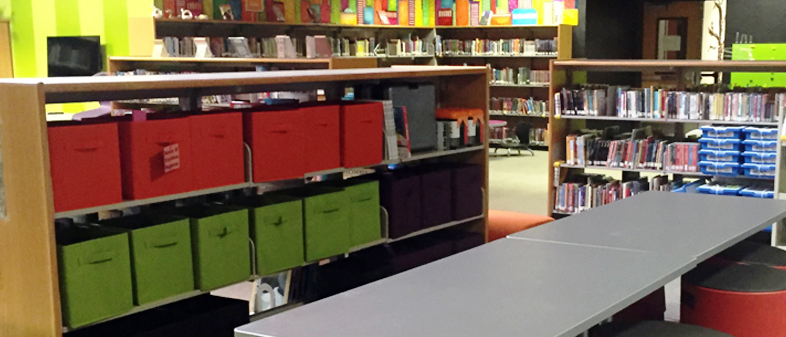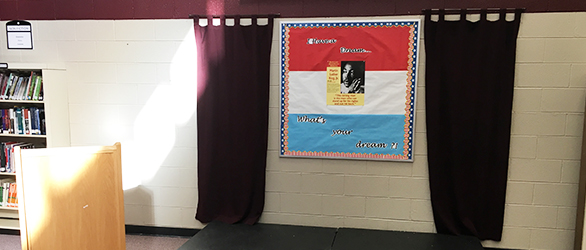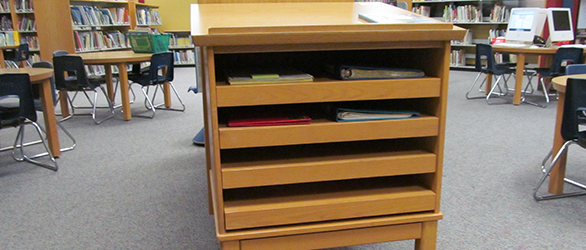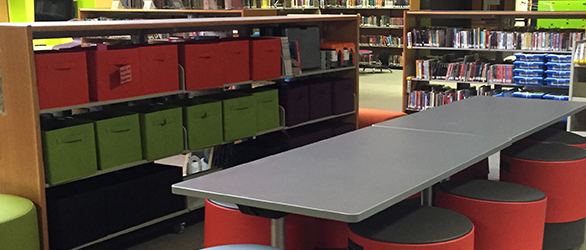
Your vision has been created - time to get to work!
Do you get out the hammer and start putting holes in the walls? Do you throw out the chair you've always hated but the kids love? What about removing the "frog collection" from three previous librarians that you have been told not to touch - oh wait, sorry, I digress.
Unfortunately, the next step is rather unglamorous. Not many people will even realize that you are working on the transformation. Collection development, or, if you prefer, collection alignment is necessary in the process. I know, big sigh! I need to be very frank here: If your collection is not relevant then the library is not relevant! Collection development is important because we cannot make the space any larger. Knowing if your collection needs to be weeded will help with space planning. Smaller collections need less shelving and leave more room for other programming. Removing printed materials does not mean fewer resources for students. Digital resources like databases and ebooks give students access to your collection 24/7.
When working with library staff, the task of weeding or deselecting materials is hard to swallow. "We are the keepers of the books! How can I remove titles? I have spent years developing this collection! I bought these books only 10 years ago! I've used that book for 20 years - why are you taking it off the shelf?" I have heard these comments from teacher librarians. I use the CREW1 method when weeding because it provides guidelines I can explain to concerned people (or busy bodies) about why books are removed. I keep a few out to show why they are being removed. One of the best examples I can give of why a weeding is necessary: While weeding at an elementary school, a book was found in the 500's about science experiments. It said to, "get a thermometer, break it open and play with the mercury". It is important to remove outdated information from the shelves.
I have observed that often after a good purge, students will come in and comment, "did you get new books?" Usually circulation increases after a weed. Library shelves are designed to be full when a quarter of the shelf is empty. For instance, would you shop at a store where reaching for one item would cause six others to fall off the shelf? Full library shelves can be frustrating to students and cause books to be disorganized.
One more story and then I am done - promise. At a high school, a thorough weeding had not been completed for more than 15 years. Imagine what we found! The librarian (new to the school and told to clean up the place) fully understood what needed to happen. Be prepared during this process - there will be questions, comments and concerns from parents, teachers, and students. At the end of the weed, we had removed 60 percent of the collection. The parents started a rumor that the library was turning into a sewing room (really, a sewing room?). I believe this rumor was started because many shelving units were removed so that the Performing Arts students had room to build a stage. On Fridays, during lunch periods, students can sign up to demonstrate their passion projects or talents. There have been a variety of presentations; a student fashion designer brought clothing that she had created, student bands have performed, several students did a poetry slam, and there even was a cooking demonstration. By doing these types of events, students and teachers who normally did not use the library space are now coming in. The learning commons is now busier than anyone can remember.

After the weed has been completed, take a look at your shelving requirements. Spaces can be defined by how items are used in relation to the space. Redesigning a space does not always mean buying all new furniture; it could be just a matter of using what exists differently. Redefining a space can be a matter of moving furniture to change the space so that large purchases are not necessary in the beginning. I have some simple design philosophies for libraries and educational spaces. These design philosophies have been developed during many transitions.
- Everything in the space must serve at least a dual purpose.
- Everything must be flexible.
- Everything must be mobile - as long as it is safe for students.
- Everything needs to fit the age of the students using the space.
Here are some examples of dual purpose: Whiteboards need to be magnetic, projectable, and used as a visible thinking space. Adjustable-height flip tables can be used as vertical writing surfaces or spatial dividers. The uses are only limited by your imagination. When shopping for adjustable-height tables, simplicity and ease of operation is important. If height cannot be adjusted easily, the feature will never be used.
Hacking existing furniture can be a good use of resources. For instance, a large atlas stand was purchased for each library in our district. Normally, atlases do not survive a weeding, but in several locations, we installed casters on the legs and now the stand is a mobile self-checkout station or, because of its shelves, a circulation desk (a great option for secondary schools).

Older libraries have a circulation "boat": a huge desk that takes up a large amount of square footage. This space can be used for student learning. I am not saying that the librarian does not need a desk. What I am saying is that the librarian should be out among the students teaching, coaching, and helping. A space for library management should be set up in a quiet corner.
Now that we know how much space we have to work with, it is time to start drawing floor plans! Make sure to keep your vision and goals in mind while drawing the plans. I usually draw at least three plans using only the shelving. The first two are "normal", but the third plan is way out there and rather funky. I only use the shelving in the initial plans because furniture should be flexible and mobile. At this point, I take the plans back to the stakeholders for their input. Never have they looked at a plan and said, "That's it!" Usually we take pieces and parts from all the plans to make the perfect space. There are several online programs available to draw the plans. If this part scares you, grab a tech savvy student and have them draw the plans for you. Do some research on zoning and ADA requirements for your area to be assured that you are in compliance with all laws and requirements.
Once the perfect floor plan is ready, now what? The "B" word comes into play... budget! How is this transformation going to be funded? If you have bond money, good for you - you can stop reading here and move to the new furniture section! I have transformed spaces and spent as little as $10 and up to $60,000. Sometimes the only thing we can do is to remove some unneeded shelving and rearrange it to organize the collection. Other times, a transformation needs to be phased in over several years because of funding. Think about prioritizing the biggest impact on student learning to determine where to start.
If funding for the transformation is not available from the school budget, there are other resources out there. The schools that I have worked with have used funds from parent organizations, grants (government and local) and local business. Remember the survey of use that was mentioned in the first article? Use this document to show the need of a transformation when talking to people about obtaining funding.
Some creative funding options for a few schools in my district:
- One school had a library transformation funded by a restaurant (a parent in the building).
- One school took the floor plan and drew squares over the top of the plan and asked parents to buy a square. We knew the total cost of the transformation and each square was a portion of the total cost.
- One school sold ceramic tiles for the students to decorate for the new space.
- One school weeded the collection and asked the art students to create art with the interesting, old books. This same school sells ice cream bars, drumsticks and popsicles to students and staff to raise funds for the transformation.
- One school approached the athletic department and offered a space to view films if the boosters would purchase the equipment.
New Furniture
Something needs to be understood about educational manufacturers - manufacturers do not sell directly to the end user (you). A dealer partner such as School Outfitters is invaluable in the process of transforming a space. Let them know your vision, your budget and your timeline. A good dealer partner will help you with floor plans, pricing, formal quotes, delivery timelines, installation, and after-sale support. Request good, better, best pricing in the event that you need to make some budgeting decisions. If you are purchasing a good-grade quality product, try to use those items in areas that will not have as much use, saving the best quality items for high-use areas. Request information about fabric grades, laminate grades, warranties, and warranty issues. Ask questions - they are there to help you, not only to sell furniture. Dealer partners want your transformation to be a success so that you will recommend them to others.
Time to get started with the transformation of the library in your school. Take it one step at a time. The transformation will go very slowly at times, but other times you will feel like you can hardly keep up. There will be frustrations and excitement! I try to be in a school when the students first see the transformation. Walking down the hall after visiting a middle school that just opened after a transformation, two girls were excitedly saying, "Can you believe they put bar tables and stools in the library?" I prefer to call them cafe tables. But if it gets them in the door, what do I care? Remember, all of your efforts are to support the student learning now and into the future!

References
1 Larson, Jeanette. "CREW: A Manual for Weeding Modern Libraries." CREW: A Weeding Manual for Modern Libraries. Texas State Libraries, 19 Aug. 2016. Web. 05 Mar. 2017. https://www.tsl.texas.gov/ld/pubs/crew/index.html.


